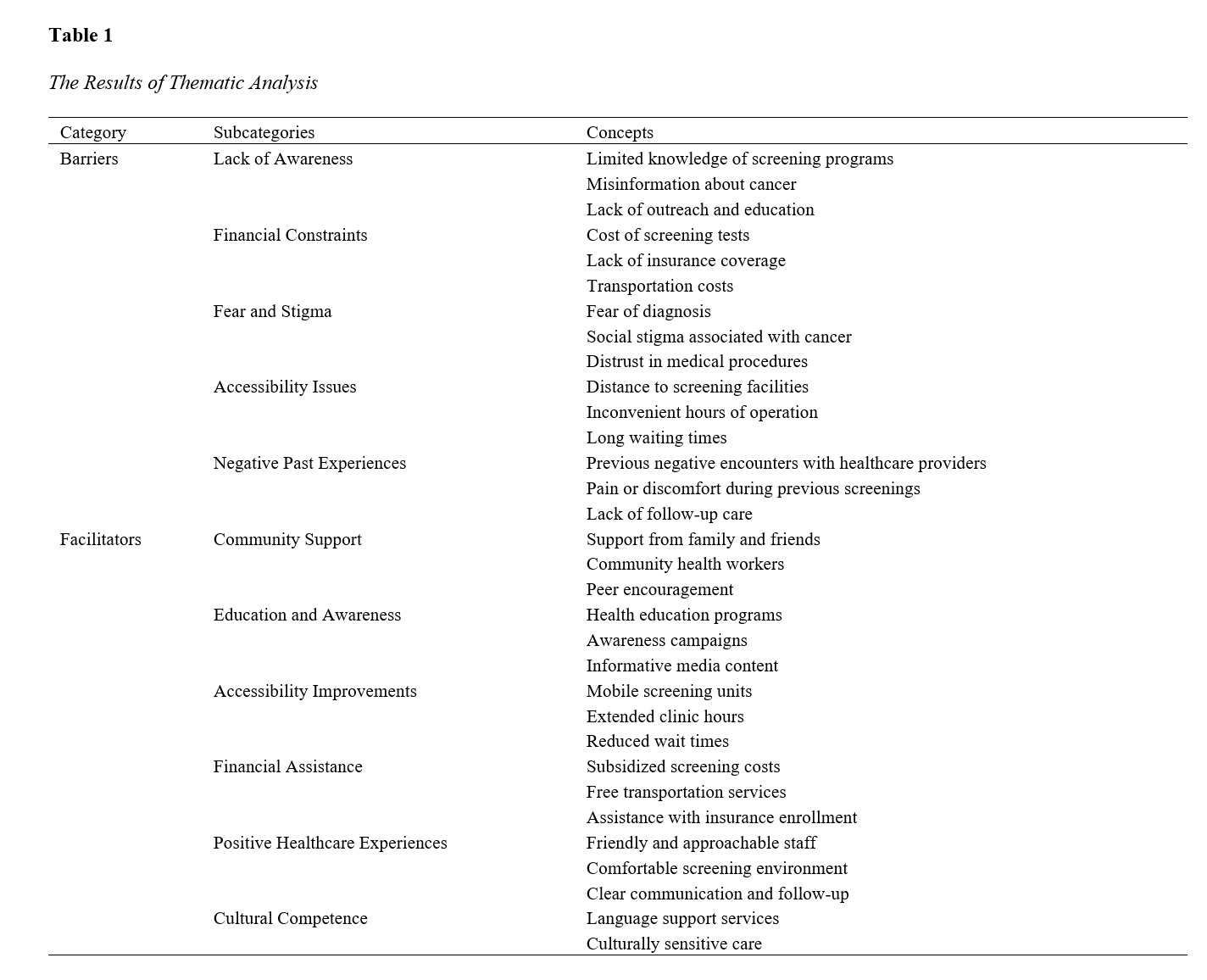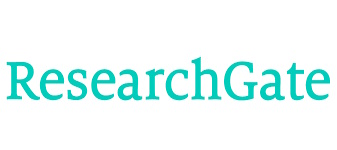Qualitative Analysis of Barriers and Facilitators to Cancer Screening in Low-Income Communities
Keywords:
Cancer screening, low-income communities, barriers, facilitators, qualitative research, healthcare disparities, community support, financial assistance, cultural competence, health educationAbstract
This study aimed to explore the barriers and facilitators to cancer screening among individuals in low-income communities. By understanding these factors, the research sought to provide insights that could inform interventions designed to increase screening rates and reduce cancer-related health disparities in these populations. A qualitative research design was employed, utilizing semi-structured interviews to collect data from 24 participants residing in low-income communities. The participants were recruited through community centers, local clinics, and public health organizations. Data collection continued until theoretical saturation was achieved. The interviews were audio-recorded, transcribed verbatim, and analyzed using NVivo software. Thematic analysis was conducted to identify key themes and patterns within the data. The study identified several barriers to cancer screening, including lack of awareness, financial constraints, fear and stigma, accessibility issues, and negative past experiences with healthcare providers. Facilitators included community support, education and awareness programs, accessibility improvements, financial assistance, positive healthcare experiences, and culturally competent care. Participants highlighted the importance of social support networks and the role of community health workers in encouraging screening participation. Financial aid and logistical improvements were also crucial in enabling access to screening services. Positive interactions with healthcare providers and culturally sensitive care emerged as significant factors in promoting screening uptake. Addressing the barriers and leveraging the facilitators identified in this study is essential for improving cancer screening rates in low-income communities. Interventions should focus on comprehensive education and awareness campaigns, financial assistance programs, and accessibility improvements. Training healthcare providers in cultural competence and fostering positive healthcare experiences can further enhance screening participation. By implementing these strategies, healthcare systems can reduce cancer-related health disparities and improve early detection in underserved populations.
Downloads
References
1. Backer EL, Geske J, McIlvain HE, Dodendorf DM, Minier WC. Improving Female Preventive Health Care Delivery Through Practice Change: An Every Woman Matters Study. The Journal of the American Board of Family Medicine. 2005;18(5):401-8.
2. Biddell CB, Spees LP, Smith JS, Brewer NT, Marais ACD, Sanusi B, et al. Perceived Financial Barriers to Cervical Cancer Screening and Associated Cost Burden Among Low-Income, Under-Screened Women. Journal of Women S Health. 2021;30(9):1243-52.
3. Castaldi M, Smiley A, Kechejian K, Butler J, Latifi R. Disparate Access to Breast Cancer Screening and Treatment. BMC Women S Health. 2022;22(1).
4. Beaudoin P-L, Anchouche S, Gaffar R, Guadagno E, Ayad T, Poenaru D. Barriers in Access to Care for Patients With Head and Neck Cancer in Resource-Limited Settings. Jama Otolaryngology–head & Neck Surgery. 2020;146(3):291.
5. Akohoue SA, Kenerson D, Takizala Z-M, Beard K, Burress M, Pinkerton H, et al. Perceptions and Receipt of Cancer Screening Among African Americans: A Community Networks Program Project. Open Journal of Epidemiology. 2016;06(04):256-70.
6. Allen‐Leigh B, Uribe-Zúñiga P, León‐Maldonado L, Brown B, Lörincz AT, Salmerón J, Lazcano‐Ponce E. Barriers to HPV Self-Sampling and Cytology Among Low-Income Indigenous Women in Rural Areas of a Middle-Income Setting: A Qualitative Study. BMC Cancer. 2017;17(1).
7. Kayser K, Washington A, Anderson GO, Harris L, Lee HY, LaJoie AS. Perceived Barriers and Facilitators in Accessing Cervical Cancer Screening. Family & Community Health. 2022;45(1):46-57.
8. Cohen EP, Wilson B, Vanderpool RC, Collins T. Identifying Sociocultural Barriers to Mammography Adherence Among Appalachian Kentucky Women. Health Communication. 2015;31(1):72-82.
9. Austad K, Chary A, Xocop SM, Messmer S, King N, Carlson L, Rohloff P. Barriers to Cervical Cancer Screening and the Cervical Cancer Care Continuum in Rural Guatemala: A Mixed-Method Analysis. Journal of Global Oncology. 2018(4):1-10.
10. Chidyaonga-Maseko F, Chirwa M, Muula AS. Underutilization of Cervical Cancer Prevention Services in Low and Middle Income Countries: A Review of Contributing Factors. Pan African Medical Journal. 2015;21.
11. Vega B, Neira VA, Segarra JIO, Andrade A, Guerra G, Ortiz S, et al. Barriers and Facilitators to Cervical Cancer Screening Among Under-Screened Women in Cuenca, Ecuador: The Perspectives of Women and Health Professionals. BMC Public Health. 2022;22(1).
12. Bevilacqua K, Gottschlich A, Murchland AR, Alvarez CS, Rivera-Andrade A, Meza R. Cervical Cancer Knowledge and Facilitators and Barriers to Screening Among Women in Two Rural Communities in Guatemala: A Qualitative Study. 2022.
13. Ndejjo R, Mukama T, Kiguli J, Musoke D. Knowledge, Facilitators and Barriers to Cervical Cancer Screening Among Women in Uganda: A Qualitative Study. BMJ Open. 2017;7(6):e016282.
14. Schliemann D, Hoe WMK, Mohan D, Allotey P, Reidpath DD, Tan M, et al. Challenges and Opportunities for Breast Cancer Early Detection Among Rural Dwelling Women in Segamat District, Malaysia: A Qualitative Study. Plos One. 2022;17(5):e0267308.
15. Nalluri H, Gaertner WB. Colon and Rectal Cancer Management in Low-Resource Settings. Clinics in Colon and Rectal Surgery. 2022;35(05):402-9.
16. Patel MI, Agrawal M, Duron Y, O'Brien D, Koontz Z. Perspectives of Low-Income and Minority Populations With Lung Cancer: A Qualitative Evaluation of Unmet Needs. Jco Oncology Practice. 2022;18(8):e1374-e83.
17. Lewis‐Thames MW, Tom LS, Leung I, Yang A, Simon MA. An Examination of the Implementation of a Patient Navigation Program to Improve Breast and Cervical Cancer Screening Rates of Chinese Immigrant Women: A Qualitative Study. BMC Women S Health. 2022;22(1).
18. Elia CR, Devine S. Barriers and Enablers for Cervical Cancer Screening in the Pacific: A Systematic Review of the Literature. Pacific Journal of Reproductive Health. 2018;1(7):372.
19. Glaser KM. Advancing Community–academic Partnerships to Achieve Breast Health Equity: Applying the Community‐based Participatory Model to Build Capacity for Sustained Impact. Cancer. 2023;129(S19):3162-70.
20. Schiffelbein JE, Carluzzo KL, Hasson RM, Alford‐Teaster J, Imset I, Onega T. Barriers, Facilitators, and Suggested Interventions for Lung Cancer Screening Among a Rural Screening-Eligible Population. Journal of Primary Care & Community Health. 2020;11:215013272093054.
21. Jesús Md, Rodrigue CM, Rahmani S, Balamou C. Addressing Cancer Screening Inequities by Promoting Cancer Prevention Knowledge, Awareness, Self-Efficacy, and Screening Uptake Among Low-Income and Illiterate Immigrant Women in France. International Journal of Public Health. 2021;66.
22. Wee LE, Lim LM, Koh GC. Two Sides of the Coin: A Qualitative Study of Patient and Provider Perspectives on Colorectal, Breast and Cervical Cancer Screening in a Low-Income Asian Community. Proceedings of Singapore Healthcare. 2015;25(2):80-91.

Downloads
Additional Files
Published
License
Copyright (c) 2024 Michael E Singer, Mathias Bastholm (Author); Haixin Qiu (Corresponding Author)

This work is licensed under a Creative Commons Attribution-NonCommercial 4.0 International License.















